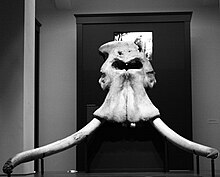
Back Palaeoloxodon antiquus AST Elefant antic Catalan Skovelefant Danish Europäischer Waldelefant German Palaeoloxodon antiquus Spanish فیل راستعاج Persian Palaeoloxodon antiquus French פיל ישר-חט HE Erdei őselefánt Hungarian Palaeoloxodon antiquus ID
| Straight-tusked elephant Temporal range: Mid-Late Pleistocene
~ | |
|---|---|

| |
| Skeleton in Rome | |

| |
| Skull in Germany | |
| Scientific classification | |
| Domain: | Eukaryota |
| Kingdom: | Animalia |
| Phylum: | Chordata |
| Class: | Mammalia |
| Order: | Proboscidea |
| Family: | Elephantidae |
| Genus: | †Palaeoloxodon |
| Species: | †P. antiquus
|
| Binomial name | |
| †Palaeoloxodon antiquus | |

| |
| Approximate range of P. antiquus | |
| Synonyms | |
|
Elephas antiquus (Falconer & Cautley, 1847)
| |
The straight-tusked elephant (Palaeoloxodon antiquus) is an extinct species of elephant that inhabited Europe and Western Asia during the Middle and Late Pleistocene (around 781,000– 40/30,000 years ago). One of the largest known elephant species, mature fully grown bulls on average had a shoulder height of 4 metres (13 ft) and a weight of 13 tonnes (29,000 lb). Straight-tusked elephants likely lived very similarly to modern elephants, with herds of adult females and juveniles and solitary adult males. The species was primarily associated with temperate and Mediterranean woodland and forest habitats, flourishing during interglacial periods, when its range would extend across Europe as far north as Great Britain and eastwards into Russia. Skeletons found in association with stone tools and wooden spears suggest they were scavenged and hunted by early humans, including Neanderthals. It is the ancestor of most dwarf elephants that inhabited islands in the Mediterranean.
- ^ Benoit, J., Legendre, L. J., Tabuce, R., Obada, T., Mararescul, V., & Manger, P. (2019). Brain evolution in Proboscidea (Mammalia, Afrotheria) across the Cenozoic. Scientific Reports, 9(1), 9323. https://doi.org/10.1038/s41598-019-45888-4